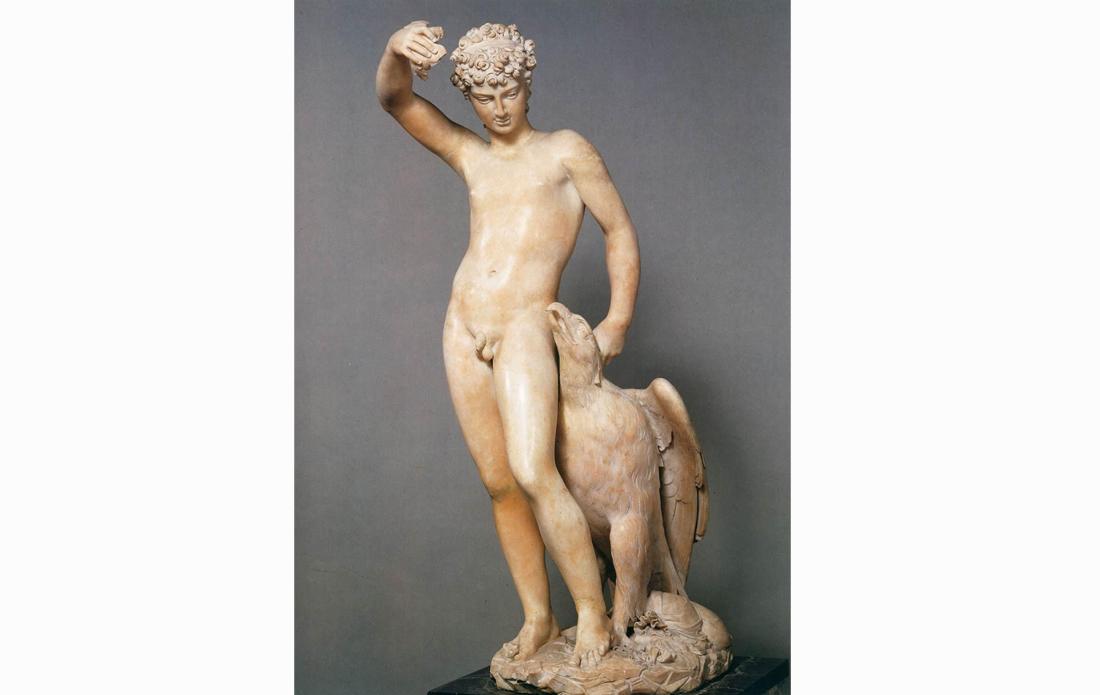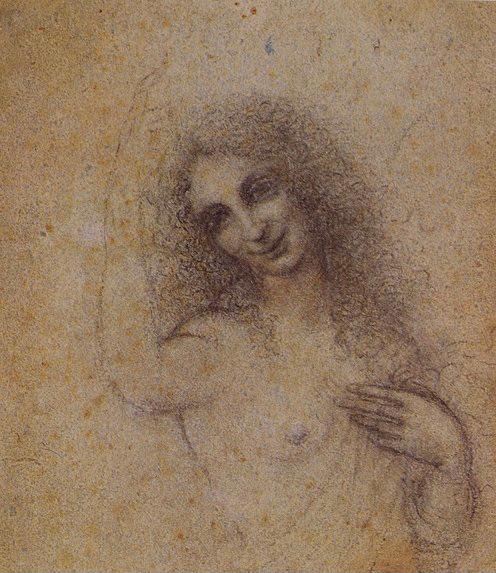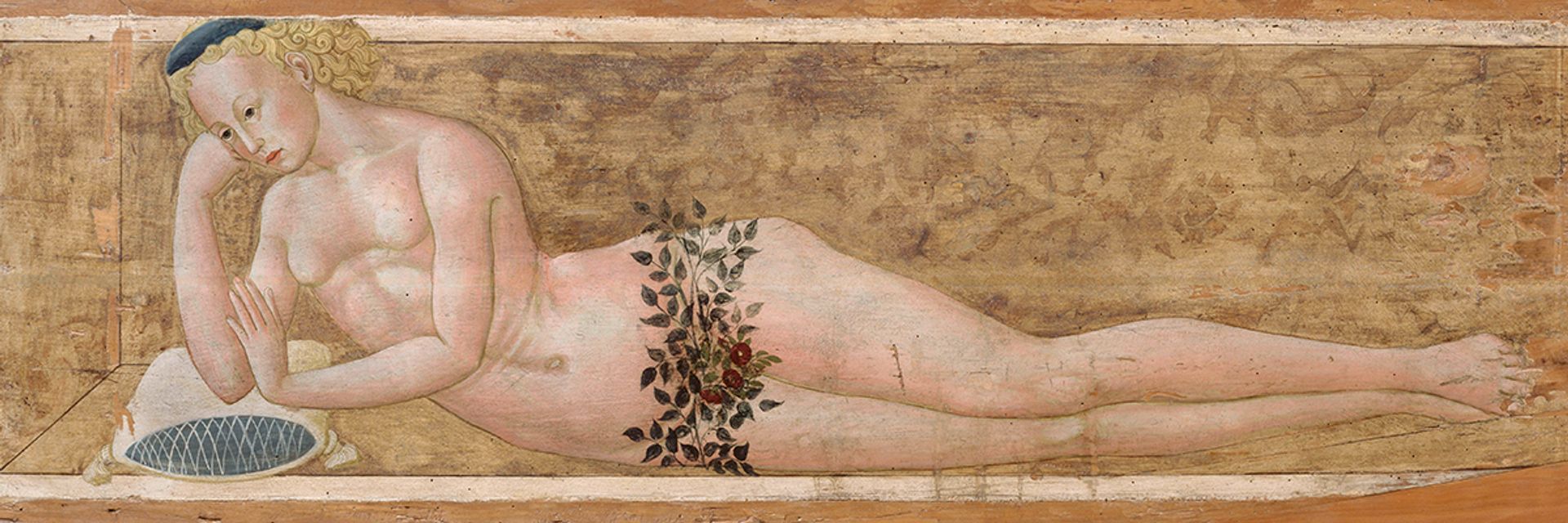In early Renaissance Florence, one Neoclassical idea of the day elevated the love between men to the highest form of spiritual love on Earth, and many men in Florence took that message to heart. When Leonardo da Vinci arrived in Florence as a young artist’s apprentice, Florence’s nighttime environment of carousing males drew him in, until Florence’s “vice squad,” the notorious Office of the Night, received a complaint about him and a group of friends.
◊
Jacopo Saltarelli was an enterprising – and entertaining – young man about town in 15th century Florence. During the day, he toiled as an apprentice goldsmith, but during Florence’s warm, inviting evenings, the 17-year-old served as a companionable friend and guide to slightly older groups of gentlemen, most in their 20s, looking for, let’s say, the sensual pleasure the night had to offer. Jacopo was a pro, well known to Florence’s authorities as what we’d now term a sex worker.
He was also a companion of Leonardo da Vinci. And in spring 1476, just days shy of his 24th birthday, Leonardo, along with Jacopo and three other alleged “clients,” were anonymously denounced to the city’s morals enforcers, suggestively named the Office of the Night. The language of the complaint is pretty salty. Here’s a brief excerpt: “Jacopo pursues many immoral activities and consents to satisfy those persons who request such sinful things from him. . . . [H]e has provided such services to many dozens of persons (who) have sodomized the said Jacopo and so I will swear.”
Accounts vary, but Leonardo may have been briefly imprisoned over this allegation. In the end, though, given the morals and customs of early Renaissance Florence, Leonardo need not have worried. The charges were all dropped, and the men – and boy – were free to continue their nocturnal ways.
But why? A quick view of Florentine culture will reveal some reasons for the seeming moderation of views toward non-procreative sexual behavior.
Renaissance Florence and the Companionship of Men
It was a risk worth taking. Every night through the streets of Florence, men were free to wander. They gathered in small groups in taverns and on the streets, while the women were sequestered in their domiciles. It was an unusual time: The 15th century marked the first years of free social movement through the Italian peninsula after the long years of the Black Plague. And while the days were for business, trade, and the machinations of society, nights were for adventure.
In the deep shadows of the Florentine evening, men took delight in their amatory perambulations. They strolled (or, we might say, cruised) through the city, where the thrill of adventure – and the allure of vice – animated their nocturnal activities. Respectable women would never be seen unaccompanied after nightfall, so Florence after dark was a men-only playground.
And what vices were available to the men of early Renaissance Florence? In addition to the lure of the strong drink and fraternal companionship of the city’s tavern culture, there were few limitations on men visiting brothels. In fact, in 1403 the city of Florence founded an office expressly to promote brothels. (Half a century earlier, in 1358, another prominent Italian city, Venice, had legalized female prostitution.)
And yet, not every man was a brothel habitué. The cost alone put these particular diversions out of the reach of many. And besides, there were other pleasures of the night that Florentine men regularly enjoyed – and for which they were well known. Let’s put it this way: As far away as Germany, the name for a man from Florence, Florenzer, was common slang for (have you guessed it yet?) a man who sought pleasure from sex with another male.
The Office of the Night and the Men of Florence
In Florence of the 1400s, the “love that dare not speak its name” literally had no “name” to speak; there was no word to classify someone who sought out this behavior. It would be another four centuries before the invention of the hybrid term homosexual (homo, meaning same, from the Greek; sexus from Latin) gave at least a term of classification to use. But in Renaissance Florence there certainly was a word under which these activities, and others too polymorphously perverse to enumerate, were gathered: sodomy.
Pre-Renaissance, most people (outside royalty) slept communally in their homes on beds of hay and straw. Private bedrooms and better bedding were introduced in the 15th century, which added comfort and privacy to night-time routines.
In that era, though, sodomy defined a much broader set of behaviors than it covers today. Any sexual behavior whose intended goal was anything other than reproduction (and in the only acceptable style, the “missionary position”) was termed sodomy, and was not only discountenanced by the powerful Catholic Church but officially illegal.
To address this widespread (and far-flung) belief about sodomites running through the streets of Florence after dark, magistrates created the Office of the Night. For 70 years, beginning in 1432, the office was charged with receiving complaints, investigating claims, and meting out punishment for acting against the public order – not to mention, against the natural order.
.jpg)
Michelangelo painted a group of desperate homosexuals locked in their (presumably) final kisses and embraces before being cast to Hades. The Last Judgment (detail), 1541. (Image Credit: Wikimedia/Public Domain)
According to statistics on the Office of the Night compiled by historian Michael Rocke for his 1997 book Forbidden Friendships, the magistrates were remarkably tolerant. In the last 40 years the office existed, nearly 17,000 men of Florence were officially incriminated for sodomy. (The city had an overall population of about 40,000 during this period.) But of those 17,000, only the most egregious repeat offenders, with at least five convictions, were given punishments beyond fines. Approximately 60 men in that time period were sentenced to exile or execution.
Florence and the Neo-Platonists: A Renaissance of Classical Ideals
Other than Christian charity, why were so many accused, and so few punished severely? Social beliefs, and a relative tolerance for homosexual behavior – within certain bounds – colored the official responses. In Florence, and throughout early Renaissance Italy, sexual behavior involving younger men and boys (from puberty to 20) with unmarried older men (up to 30) was accepted as a “normal” (if not natural) mark of growing maturity.
In Venice, where certain men were also known to partake in taboo sexual behavior, the city’s response was harshly different. Venice’s Council of Ten, analogous to Florence’s Office of the Night, was rather more vicious, burning scores of sodomites at the stake.
Active in Florence of the day was a group of influential scholars called the Neo-Platonists. They sought to bring about a rebirth (literally a renaissance) of the values and beliefs of the Classical Era, drawing on the teachings of Socrates and Plato whose teachings were being rapidly rediscovered after the era of the Black Plague.

According to Neoplatonic myth, Zeus was enamored of the youth Ganymede, and transformed himself into an eagle to abduct him. Benvenuto Cellini, Ganymede, 1540. (Image Credit: Wikimedia/Public Domain)
The prime belief of the Platonists was that the purpose of life was to honor the divine, and that the highest form of divine love was shared by the gods with men (specifically above the love of gods for women). This was the route to “unity,” the commingling of human and spiritual love. The Neo-Platonists drew on these Platonic ideals but interpreted them in the light of Christian thought. In Florence, thinkers such as Marsilio Ficino established an informal Florentine Academy to promulgate these ancient principles.
The Matter of Leonardo da Vinci
Around the year 1466, when Leonardo was 14, he was apprenticed by his father to the artistic studio of Andrea del Verrocchio, and so departed the small town of Vinci in the Republic of Florence. At the time, such apprenticeships were common for boys as young or even younger than Leonardo. So, here’s a prodigiously talented 14-year-old on his own in the “big city” of Florence, where, despite his age, he started leaving an outsize impression among the artistic circles there.
Within 10 years of the beginning of his apprenticeship, by age 23, it’s said that Leonardo painted an angel so luminous, so remarkable, that his master, upon reviewing it, chose to stop painting altogether.
As a young man, Leonardo’s reputation grew. He was well known for his social as well as artistic skills, and he had already made friends at the highest levels of Florentine society, including members of Florence’s ruling family, the Medicis. These connections would serve Leonardo well, as we’ll see.

Leonardo drew this intimate sketch of Salaì, his assistant and companion, and titled it Incarnate Angel, c. 1513–1515. (Image Credit: Wikimedia/Public Domain)
When Leonardo and his friends were arrested in 1476, two things worked in favor of Leonardo: One of his nocturnal companions, Lionardo de Tornabuoni, was related by marriage to the Medici family, which was anxious for the situation to be put to rest quickly. And the anonymity of the complaint gave authorities an official reason to dismiss it.
Because Leonardo had not yet earned his esteemed place in society, it’s unlikely he received any special favors due to his social ranking. One wonders if the entire affair was simply meant to embarrass Leonardo and the others, since the accusations were unsigned. In fact, just months after the first charges, another anonymous statement was sent to the Office of the Night again naming the “gang of four” for officially taboo sexual behavior. Because the accuser was once again unnamed, the second round of charges were dismissed as well.
Leonardo: A Master of Emotion, If Not Desires
Leonardo is often presumed to have foregone carnal pleasures in his singular pursuit of artistic inspiration. He stated, “Whoso curbs not lustful desires puts himself on a level with the beasts.” But we can see in his work a full engagement with the physical world and the many emotions expressed by men as well as women. Whether he was “scared straight” – or at least set on a path to celibacy – by his experiences with the Office of the Night is a matter left to conjecture. But at least in his artwork, imbued with light, and passion, and transcendence, we can see the full-blooded man, able to experience and represent all the emotions, including lust and cupidity, through the works he created.
It is clear, too, that Leonardo was a man of his time – and of the places where he lived. Perhaps in his later career, having left the relatively tolerant city of Florence, his public persona changed along with his addresses, even if, in his private life, he continued his relationships with male paramours. Such was the necessity if he was to continue with his high-profile commissions, such as the Mona Lisa. Those evening strolls through the streets of Florence were but a fleeting chapter of a life he intended to remain hidden.
Ω
Kevin Martin is Senior Writer for MagellanTV. He writes on a wide variety of topics, including outer space, the fine arts, and modern history. He has had a long career as a journalist and communications specialist with both nonprofit and for-profit organizations. He resides in Glendale, California.
Title Image: Giovanni di Ser Giovanni Guidi (Lo Scheggia), Reclining Young Man, c. 1450 (Image Credit: Réunion des Musées Nationaux/Art Resource, NY)

